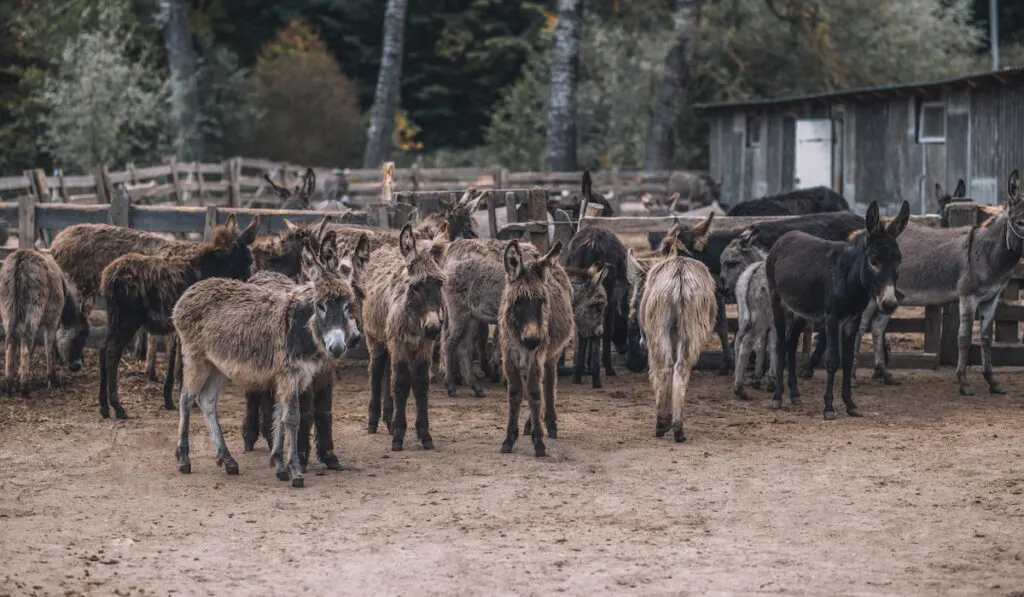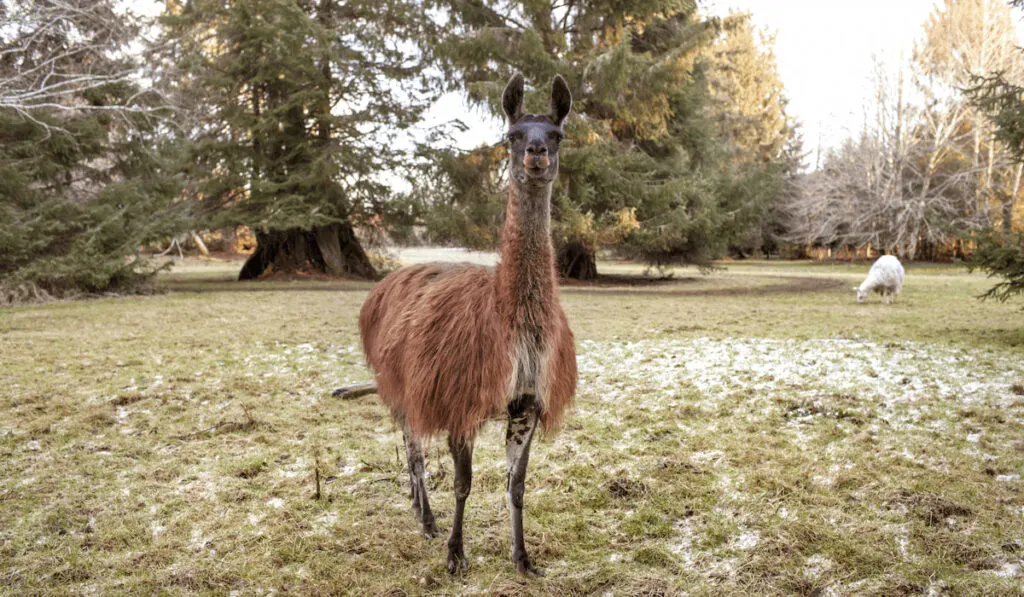Keeping your livestock safe is a 24-hour a day job. Thankfully, there are animals that can handle that job with ease. Llamas and donkeys make excellent guard animals, but deciding which one is right for your farm is a tough decision.

Choosing between getting a guard donkey or a guard llama can be overwhelming.
Each of these guardian animals brings a little something different to the farm table and they may or may not be right for your specific farm.
Learning what llamas and donkeys can offer a farm security-wise is the only way to make the right decision for your farm.
Table of Contents
Guard Llamas
Nutrition Requirements
Llamas require large amount of forage in their diets. Grains and supplements specifically designed for camelids can be added if the forage quality is low.
A guard llama should be separated from the livestock during grain feedings.
Llamas are not prone to bloat like cattle and other ruminants. Llamas are, however, more susceptible to glucose and have a moderate amount of insulin resistance.
Sweet feeds and sugary treats should be avoided altogether. The body condition of a llama should be monitored monthly to prevent excessive weight loss or disease. (source)
Care and Upkeep
Llamas do require regular care and upkeep. A full body check including examining skin, foot, and nail health should be done at least monthly.
Llama owners should look for things like mites, skin parasites, limping, or limited range of motion in limbs and joints.
Daily or, at the least, weekly visual checks are imperative to spot illness, fatigue, or injury. Llamas need their nails trimmed regularly to prevent injury and overgrowth.
Shearing may need to be done if llamas become overloaded by their wool, especially during warm temperatures. (source)
The Predators Llamas Will Defend Against
Guard llamas will protect a livestock herd from several different predators. Often, their defensive demeanor will be enough to ward off an attacker. Guard llamas will attack and sometimes kill coyotes, predatory wild and domesticated dogs, and foxes.
A llama does best against a single predator and often fares poorly against a pack of predatory animals. (source)
How Many Guard Llamas Do You Need?

If you decide to get a guard llama, you will only need one. Research done on the subject indicates that more than one llama as a livestock guard animal could render them unsuccessful.
A llama will bond with other llamas and protect them instead of your livestock. A single llama will bond with the livestock and feel protective of them. (source)
A single llama can protect up to 300 sheep over up to 300 acres of land. With just one guard llama on the premises, livestock owners can potentially see their losses to predators diminished all the way to zero.
Livestock Llamas Protect Best
Guard llamas are ideal for protecting smaller livestock such as sheep and goats. Llamas bond particularly well with the young offspring of most livestock, developing a sense of protectiveness that inspires them to stand guard over the herd. (source)
Male or Female?
In the past, many livestock owners have used gelded male llamas to protect their livestock. Lately, however, they have found that a lone unbred female llama is a more efficient guard overall.
She poses less of an injury risk to the livestock and is more protective, especially of the young. A female guard llama will not chase the livestock as much as a male will. (source)
Training Requirements
There are no specific training requirements for a guard llama. While not all llamas will have a guardian instinct, those that do will have it naturally.
Once they bond with your herd, a guard llama should instinctively protect the livestock from predators. Bonding with livestock usually takes a few days to a week.
Cost
A guard llama can cost anywhere from a couple hundred dollars to upwards of $1,500.
It depends on the training and breeding background. If you are not looking to breed the llama, you can avoid registered llamas or llamas bred for their color.
Guard Donkeys
Nutritional Requirements
Donkeys require forage in their diets, and they can survive on shrubbery and flowering plants. Straw is a better option for donkeys than hay, but they can eat hay if needed.
A donkey’s digestive system was designed to survive on low-quality forage. This means that donkey owners must be careful not to overfeed them on high-quality hay or allow them to free range on lush pastures.
A donkey can quickly become overweight and suffer from laminitis if their diet is too rich. (source)
This may mean that livestock owners would need to grain feed their livestock separately from the donkey to keep them healthy.
Care and Upkeep
While some donkey owners say they require no upkeep, that is not necessarily the case.
The truth is, there is some regular care required to keep your guard donkey in top working order.
Their weight should be monitored regularly, watching for rapid weight gain or limping.
An inability to walk normally could indicate laminitis from overgrazing on rich grasses or hay. Apart from their diet, special attention should be placed on the length of their hooves, which need trimming at least every 4 months. (source)
What Predators Will Guard Donkeys Defend Against?
A guard donkey will attack and sometimes even kill predators such as wolves, wild and domestic dogs, coyotes, bobcats and foxes. While it is not common, some have even been known to attack or defend against mountain lions.
How Many Guard Donkeys Do You Need?

It is recommended to only have one guard donkey per pasture when using them as a livestock guard animal.
Donkeys will often bond with other donkeys if they are housed in the same pasture or paddock, protecting only themselves and sometimes ignoring the herd.
A lone donkey will bond more easily with the livestock and protect the entire herd. (source)
Male or Female?
Most livestock owners find that female donkeys make the best guard donkeys.
Uncastrated male donkeys can be dangerous to livestock because they can become aggressive during in-heat seasons. Gelded, or castrated, male donkeys can also make good guard donkeys.
Livestock Donkeys Protect Best
Guard donkeys are best at protecting cattle, sheep, and goats from predators. Guard donkeys may not bond with the livestock as fiercely as some llamas do, but they will fend off predators. (source)
Training Requirements
Guard donkeys generally require no training. A donkey’s instinct is to protect itself from predators at all costs. While other animals run from a fight, a donkey instinctively will run towards danger.
A donkey can bond with the livestock herd by being sheltered close to them for a week or two.
It is important to know that not every donkey will be compatible with the livestock, so a trial period should be given to see how they interact together. Most donkeys will bond with the livestock and protect them like their own. (source)
Cost
A standard-sized guard donkey can cost between $100 to $500. Hoof trimmings will cost around $25 to $50 per visit, totaling up to a maximum of $200 annually.
Another option is to adopt a formerly wild donkey from the Bureau of Land Management. The BLM offers donkeys for as little as $25. You can even get one with basic training for $125.
Considerations
It is important to note that donkeys come in a variety of sizes, from miniature to standard to large.
Miniature donkeys are too small to be effective at fending off a predator. Large donkeys can protect the herd but pose more risk for injury if they become hard to handle.
Standard size donkeys are the ideal size for guard donkeys. They are large enough to fight off a predator but small enough to be handled by their owner when needed. (source)
Guard Llama or Guard Donkey?
| Guard Llama | Guard Donkey | |
| Livestock They Protect Best | Sheep, Goats | Cattle, Sheep, Goats |
| Predators They Kill/Stop | Coyotes, Wild Dogs, Predatory Dogs, Foxes | Wolves, Wild and Predatory Dogs, Foxes, Bobcats |
| Male or Female | Unbred Female or Castrated Male | Unbred Female or Castrated Male |
| Number Need Per Pasture | 1 | 1 |
| Cost | $200-$1,500 | $100-$500 |
| Training Required | None | None |
| Bonding Time Needed | Few days to a Week | One or Two Weeks |
Final Thoughts
Deciding between a guard llama and a donkey may have seemed difficult, but you should have a clearer idea now. Guard llamas protect sheep and goats best, and they are ideal for fending off coyotes and wild dogs.
Guard donkeys can protect cattle, sheep or goats and they are best at keeping wolves, coyotes, dogs and bobcats off your property. Neither require much training, but both will need to bond with the livestock you want them to protect.
Resources:
http://www.rmla.com/html/guarding.html
